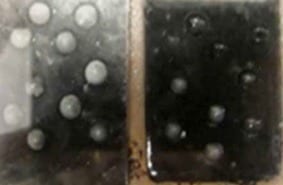
The photolithography process used to create the features on computer chips has remained largely unchanged in the last 50 years. But as chip manufacturers continue to cram more and more circuits onto a chip the limitation of this process is rapidly being reached. Potential solutions to keep apace with Moore’s Law include using DNA molecules as scaffolding, replacing copper interconnects with graphene and using plasma beams. Now researchers at MIT are developing a process that could see tiny circuits being created using molecules that automatically arrange themselves into useful patterns.
Photolithography involves chips being built up layer by layer. A layer of silicon, metal, or some other material is deposited on a chip and coated with a light-sensitive material, called a photoresist. Light shining through a kind of stencil – a “mask” – projects a detailed pattern onto the photoresist, which hardens where it’s exposed. The unhardened photoresist is washed away, and chemicals etch away the bare material underneath.
This process has served chip makers well for the last 50 years but the problem is that chip features are now significantly smaller than the wavelength of the light used to make them. Manufacturers have developed various tricks to get light to produce patterns smaller than its own wavelength, but they won’t work at smaller scales.
The obvious way to continue shrinking chip features would be to use beams of electrons to transfer mask patterns to layers of photoresist. But unlike light, which can shine through a mask and expose an entire chip at once, an electron beam has to move back and forth across the surface of a chip in parallel lines, like a harvester working along rows of wheat. This makes electron-beam lithography significantly more expensive than conventional optical lithography.
MIT researchers led by Caroline Ross, the Toyota Professor of Materials Science and Engineering, and Karl Berggren, the Emanuel E. Landsman Associate Professor of Electrical Engineering, have developed a new approach that uses electron-beam lithography much more sparingly, to create patterns of tiny posts on a silicon chip. They then deposit specially designed polymers — molecules in which smaller, repeating molecular units are linked into long chains — on the chip. The polymers spontaneously hitch up to the posts and arrange themselves into useful patterns.
Related articles by Zemanta
- MIT building self-assembling computer chips (news.cnet.com)
- M.I.T. Researchers Create Molecular Chips (bits.blogs.nytimes.com)
- Microprocessor mega-shocker: self-assembling silicon chips could lead to ever smaller circuitry (engadget.com)








![Reblog this post [with Zemanta]](http://img.zemanta.com/reblog_b.png?x-id=5eb95408-9963-4761-81e9-f0f6712916f6)
